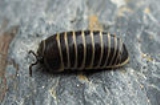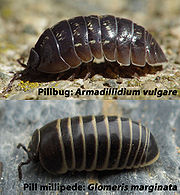
Pill millipede
Encyclopedia
Pill millipedes make up two orders
of millipede
s, often grouped together into a single superorder, Oniscomorpha. The name Oniscomorpha refers to the resemblance of pill millipedes to certain woodlice
, namely the pillbugs of the family Armadillidiidae
, also called "potato bugs", "doodlebugs", or "roly-polies". However, they are only distantly related.
Pill millipedes are short compared to other millipedes, with only eleven to thirteen body segments, and are capable of rolling into a ball when disturbed. This ability may however have evolved
separately in each of the two orders, making it a case of convergent evolution
, rather than homology
. Pill millipedes are detritivorous
, feeding on decomposing plant matter, usually in woodland
s.

and includes species such as Glomeris marginata
, the common European pill millipede. They have from eleven to twelve body segments, and lack the defensive repugnatorial glands found on many other millipedes. The order contains members in Europe, South-east Asia
and the Americas
from California
to Guatemala
. Three species are present in the British Isles
.
is a Gondwana
-distribution taxon, with around 100 species in southern Africa
, Madagascar
, Australasia
and South East Asia. They have thirteen body segments, and do not possess repugnatorial glands. Five species, all in the genus Procyliosoma
are present in New Zealand
, and around thirty species in three or more genera are present in Australia
.
Order (biology)
In scientific classification used in biology, the order is# a taxonomic rank used in the classification of organisms. Other well-known ranks are life, domain, kingdom, phylum, class, family, genus, and species, with order fitting in between class and family...
of millipede
Millipede
Millipedes are arthropods that have two pairs of legs per segment . Each segment that has two pairs of legs is a result of two single segments fused together as one...
s, often grouped together into a single superorder, Oniscomorpha. The name Oniscomorpha refers to the resemblance of pill millipedes to certain woodlice
Woodlouse
A woodlouse is a crustacean with a rigid, segmented, long exoskeleton and fourteen jointed limbs...
, namely the pillbugs of the family Armadillidiidae
Armadillidiidae
Armadillidiidae is a family of woodlice, a terrestrial crustacean group in the order Isopoda. Unlike members of other woodlouse families, members of this family can roll into a ball, an ability they share with the outwardly similar but unrelated pill millipedes and other animals...
, also called "potato bugs", "doodlebugs", or "roly-polies". However, they are only distantly related.
Pill millipedes are short compared to other millipedes, with only eleven to thirteen body segments, and are capable of rolling into a ball when disturbed. This ability may however have evolved
Evolution
Evolution is any change across successive generations in the heritable characteristics of biological populations. Evolutionary processes give rise to diversity at every level of biological organisation, including species, individual organisms and molecules such as DNA and proteins.Life on Earth...
separately in each of the two orders, making it a case of convergent evolution
Convergent evolution
Convergent evolution describes the acquisition of the same biological trait in unrelated lineages.The wing is a classic example of convergent evolution in action. Although their last common ancestor did not have wings, both birds and bats do, and are capable of powered flight. The wings are...
, rather than homology
Homology (biology)
Homology forms the basis of organization for comparative biology. In 1843, Richard Owen defined homology as "the same organ in different animals under every variety of form and function". Organs as different as a bat's wing, a seal's flipper, a cat's paw and a human hand have a common underlying...
. Pill millipedes are detritivorous
Detritivore
Detritivores, also known as detritophages or detritus feeders or detritus eaters or saprophages, are heterotrophs that obtain nutrients by consuming detritus . By doing so, they contribute to decomposition and the nutrient cycles...
, feeding on decomposing plant matter, usually in woodland
Woodland
Ecologically, a woodland is a low-density forest forming open habitats with plenty of sunlight and limited shade. Woodlands may support an understory of shrubs and herbaceous plants including grasses. Woodland may form a transition to shrubland under drier conditions or during early stages of...
s.

Glomerida
The Order Glomerida is found in the Northern HemisphereNorthern Hemisphere
The Northern Hemisphere is the half of a planet that is north of its equator—the word hemisphere literally means “half sphere”. It is also that half of the celestial sphere north of the celestial equator...
and includes species such as Glomeris marginata
Glomeris marginata
Glomeris marginata is a common European species of pill millipede. It is a short millipede, rounded in cross-section, which is capable of rolling itself up into a ball when disturbed. This behaviour is also found in the pill woodlouse Armadillidium, with which G...
, the common European pill millipede. They have from eleven to twelve body segments, and lack the defensive repugnatorial glands found on many other millipedes. The order contains members in Europe, South-east Asia
Southeast Asia
Southeast Asia, South-East Asia, South East Asia or Southeastern Asia is a subregion of Asia, consisting of the countries that are geographically south of China, east of India, west of New Guinea and north of Australia. The region lies on the intersection of geological plates, with heavy seismic...
and the Americas
Americas
The Americas, or America , are lands in the Western hemisphere, also known as the New World. In English, the plural form the Americas is often used to refer to the landmasses of North America and South America with their associated islands and regions, while the singular form America is primarily...
from California
California
California is a state located on the West Coast of the United States. It is by far the most populous U.S. state, and the third-largest by land area...
to Guatemala
Guatemala
Guatemala is a country in Central America bordered by Mexico to the north and west, the Pacific Ocean to the southwest, Belize to the northeast, the Caribbean to the east, and Honduras and El Salvador to the southeast...
. Three species are present in the British Isles
British Isles
The British Isles are a group of islands off the northwest coast of continental Europe that include the islands of Great Britain and Ireland and over six thousand smaller isles. There are two sovereign states located on the islands: the United Kingdom of Great Britain and Northern Ireland and...
.
Sphaerotheriida
The Order SphaerotheriidaSphaerotheriida
Sphaerotheriida is an order of millipedes in the subclass Pentazonia, sometimes known as giant pill millipedes. They inhabit the Southern Hemisphere. Like the Northern Hemisphere pill millipedes of the order Glomerida, these millipedes can roll into a ball when disturbed...
is a Gondwana
Gondwana
In paleogeography, Gondwana , originally Gondwanaland, was the southernmost of two supercontinents that later became parts of the Pangaea supercontinent. It existed from approximately 510 to 180 million years ago . Gondwana is believed to have sutured between ca. 570 and 510 Mya,...
-distribution taxon, with around 100 species in southern Africa
Southern Africa
Southern Africa is the southernmost region of the African continent, variably defined by geography or geopolitics. Within the region are numerous territories, including the Republic of South Africa ; nowadays, the simpler term South Africa is generally reserved for the country in English.-UN...
, Madagascar
Madagascar
The Republic of Madagascar is an island country located in the Indian Ocean off the southeastern coast of Africa...
, Australasia
Australasia
Australasia is a region of Oceania comprising Australia, New Zealand, the island of New Guinea, and neighbouring islands in the Pacific Ocean. The term was coined by Charles de Brosses in Histoire des navigations aux terres australes...
and South East Asia. They have thirteen body segments, and do not possess repugnatorial glands. Five species, all in the genus Procyliosoma
Procyliosoma
Procyliosoma is a genus of pill millipede of the family Sphaerotheriidae, found in Australia and New Zealand.-Species:* Procyliosoma andersoni – New South Wales* Procyliosoma aurivillii Silvestri, 1917 – Queensland...
are present in New Zealand
New Zealand
New Zealand is an island country in the south-western Pacific Ocean comprising two main landmasses and numerous smaller islands. The country is situated some east of Australia across the Tasman Sea, and roughly south of the Pacific island nations of New Caledonia, Fiji, and Tonga...
, and around thirty species in three or more genera are present in Australia
Australia
Australia , officially the Commonwealth of Australia, is a country in the Southern Hemisphere comprising the mainland of the Australian continent, the island of Tasmania, and numerous smaller islands in the Indian and Pacific Oceans. It is the world's sixth-largest country by total area...
.

